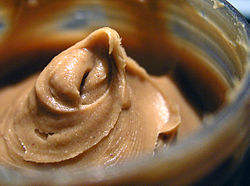Peanut butter

"Smooth" peanut butter in a jar
|
|
| Type | Spread |
|---|---|
| Main ingredients | Peanuts |
| |
|
| Nutritional value per 100 g (3.5 oz) | |
|---|---|
| Energy | 2,462 kJ (588 kcal) |
|
20 g
|
|
| Starch | 4.8 g |
| Sugars | 9.2 g |
| Dietary fiber | 6 g |
|
50 g
|
|
|
25 g
|
|
| Vitamins | |
| Thiamine (B1) |
(10%)
0.11 mg |
| Riboflavin (B2) |
(9%)
0.11 mg |
| Niacin (B3) |
(88%)
13.2 mg |
| Pantothenic acid (B5) |
(22%)
1.1 mg |
| Vitamin B6 |
(42%)
0.55 mg |
| Folate (B9) |
(9%)
35 μg |
| Vitamin E |
(39%)
5.9 mg |
| Minerals | |
| Calcium |
(5%)
54 mg |
| Iron |
(17%)
2.2 mg |
| Magnesium |
(50%)
179 mg |
| Manganese |
(71%)
1.5 mg |
| Phosphorus |
(48%)
335 mg |
| Potassium |
(14%)
649 mg |
| Sodium |
(0%)
0 mg |
| Zinc |
(28%)
2.7 mg |
| Other constituents | |
| Water | 1.8 g |
| Alcohol (ethanol) | 0 g |
| Caffeine | 0 mg |
|
|
| Percentages are roughly approximated using US recommendations for adults. Source: USDA Nutrient Database |
|
Peanut butter is a food paste popular in many countries, a spread made primarily from ground dry roasted peanuts, but often containing additional ingredients that modify the taste or texture. The United States is a leading exporter and itself consumes $800 million of peanut butter annually. Comparable preparations with other nuts make for a variety of nut butters.
The use of peanuts dates to the Aztecs and Incas, and peanut paste may have been used by the Aztecs as a toothache remedy in the first century of the Common Era (CE).
Marcellus Gilmore Edson (1849 – 1940) of Montreal, Quebec (in Canada) was the first to patent peanut butter in 1884. Edson's cooled product had "a consistency like that of butter, lard, or ointment" according to his patent application which described a process of milling roasted peanuts until the peanuts reached "a fluid or semi-fluid state". He mixed sugar into the paste to harden its consistency.
John Harvey Kellogg, known for his line of prepared breakfast cereals, was issued a patent for a "Process of Producing Alimentary Products" in 1898, and used peanuts, although he boiled the peanuts rather than roasting them. Kellogg served peanut butter to the patients at his Battle Creek Sanitarium.
Early peanut-butter-making machines were developed by Joseph Lambert, who had worked at John Harvey Kellogg's Battle Creek Sanitarium, and Dr. Ambrose Straub who obtained a patent for a peanut-butter-making machine in 1903. "In 1922, chemist Joseph Rosefield invented a process for making smooth peanut butter that kept the oil from separating by using partially hydrogenated oil"; Rosefield "...licensed his invention to the company that created Peter Pan peanut butter" in 1928 and in "...1932 he began producing his own peanut butter under the name Skippy".
...
Wikipedia
